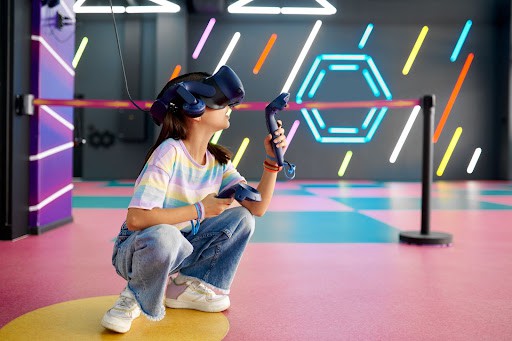
The Metaverse and other virtual worlds show that we are rapidly approaching a virtual future. Also, we can expect virtual reality to have the same transformative effect on society as the internet. For example, if you want to have a real racing experience, you can use racing simulators, if you want to experience flying a plane, you can use flight simulators, and so on.
Virtual reality devices are an integral part of experiencing virtual reality. They enclose the user’s eyes with a screen installed on their head to create a convincing simulation of an otherwise real environment. The potential impact on users’ eyesight is a major issue for early adopters of this cutting-edge technology.
So, how risky is it to use virtual reality? Let’s find out.
Is VR Bad for Your Eyes?
Yes.
As with many technological developments, social media’s positive effects on communication come at the expense of its negative effects on mental health. Cryptocurrency can benefit financial inclusion, but it negatively affects the environment. Hence, no medium is perfect, and VR is no different.
These worries increase because most VR users engage in prolonged sessions. Some people have even said they felt sick after using VR for just a little while.
Virtual reality modifies our usual views by fooling our senses and brains simultaneously. In real life, when we try to focus on an object, the muscles in our eyes move the eyeball into the proper position and adjust the lenses to determine what we’re looking at. The muscles do such a thing so the brain can better understand your vision. In VR, you can’t move your eyes around the screen to focus on items at different distances. Instead, you keep your gaze locked in one place and move your head to look in different directions. This variation in visual function can present difficulties while using virtual reality.
Some of the most typical examples are:
Eye Fatigue or Eye Strain
Users frequently report feeling eye strain or weariness after an extended time in virtual reality. The main reason behind this is that wearing a VR headset causes the brain to process images incorrectly. Most virtual reality headsets have a field of view far narrower than the average human’s, roughly 200 degrees.
On top of that, the attention is directed on a near-eye pixelated screen rather than a far-reaching refractive field of view. This difference makes it harder for human eyes to pinpoint the locations of objects, resulting in fatigue and headaches from the extra effort required.
Eye strain, however, is not a serious problem and does not typically result in permanent damage. When using virtual reality, it’s important to take breaks when you sense eye strain, as advised by the American Academy of Ophthalmology.
Visually Induced Motion Sickness
Visually Induced Motion Sickness is also called cyber-sickness.
Cyber-sickness is real, and it tends to strike people who are already susceptible to dizziness or motion sickness. Illusionary movement occurs when you trick the brain into thinking the body is in motion even when it is not.
For instance, if you’re experiencing virtual reality, and the scene in question involves you sprinting, your brain may start to believe that it is truly experiencing the action. When this happens, your eyes will tell you that you’re running. However, your inner ear and body will tell you that you’re standing still, resulting in a disorienting sensory experience. Virtual reality motion sickness is especially bad when the user exposes himself to situations involving fast movement or free fall.
Dizziness
The vestibular system, a sensory apparatus located in the inner ear, is responsible for maintaining your equilibrium.
This equilibrium is made possible by the body’s ability to coordinate several sensory impulses, including those related to the eyes and the rest of the head. However, using a virtual reality headset can confuse these readings.
When wearing a virtual reality headset, these signals might become quite confusing, for example, if your eyes tell you that you’re sprinting while your head stays stationary. Also, you may feel lightheaded due to the inconsistency in sensory input.
Eye or Muscle Twitching
You can damage your eye muscles from prolonged exposure to fast light switching and movement. Rapid changes in illumination and movement are typical of virtual reality simulations, forcing the agility of your eye muscles to keep up. The inability to maintain eye stability over time may be a long-term effect detrimental to eye health.
What Are the Risks for Kids?
Children may be especially vulnerable because manufacturers design immersive VR experiences for the mobile and console gaming sectors. As much as a quarter of the gaming population is under 18. Since cognitive abilities like attention, tracking, and depth perception don’t fully mature until late elementary school, the market is full of games aimed at very young children.
This factor could increase the likelihood of youngsters developing nearsightedness (myopia) at a young age and cause digital eye strain. So get your child’s eyes checked before school starts, have them take breaks from screens for 20 seconds every 20 minutes, and require lengthier breaks during which they engage in physical activities to combat this visual stress.
What Are the Risks for Adults?
The disturbance of vergence brought on by the 3D stereoscopic effect and the phenomenon known as “virtual reality sickness” is very common and causes nausea and dizziness in adults.
Final Words
Like every technology, virtual reality has both advantages and disadvantages. However, it could bring in a new technological era once it evolves. Using it sparingly is the best way to protect your eyes from damage, as it is obvious that excessive exposure over time is bad.
Yes, we know you love the immersion and simulation that VR offers. However, it can damage your eyes to a very great extent. So, if you love gaming but still worry about your eyes, wearing gamer glasses can help.




